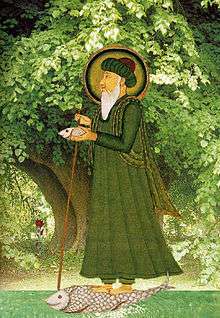Green Man
The Green Man, and very occasionally the Green Woman, is a legendary being primarily interpreted as a symbol of rebirth, representing the cycle of new growth that occurs every spring. The Green Man is most commonly depicted in a sculpture, or other representation of a face which is made of, or completely surrounded by, leaves.[1]
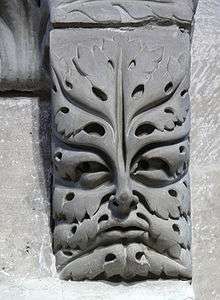
The Green Man motif has many variations. Branches or vines may sprout from the mouth, nostrils, or other parts of the face, and these shoots may bear flowers or fruit. Found in many cultures from many ages around the world, the Green Man is often related to natural vegetation deities. Often used as decorative architectural ornaments, Green Men are frequently found in carvings on both secular and ecclesiastical buildings. "The Green Man" is also a popular name for English public houses, and various interpretations of the name appear on inn signs, which sometimes show a full figure rather than just the face.
Some[2][3] speculate that the mythology of the Green Man developed independently in the traditions of separate ancient cultures and evolved into the wide variety of examples found throughout history.
Types


Usually referred to in works on architecture as foliate heads or foliate masks, carvings of the Green Man may take many forms, naturalistic or decorative. The simplest depict a man's face peering out of dense foliage. Some may have leaves for hair, perhaps with a leafy beard. Often leaves or leafy shoots are shown growing from his open mouth and sometimes even from the nose and eyes as well. In the most abstract examples, the carving at first glance appears to be merely stylised foliage, with the facial element only becoming apparent on closer examination. The face is almost always male; green women are rare.
Julia, Lady Raglan applied the term "Green Man" to this type of architectural feature in her 1939 article "The Green Man in Church Architecture" in The Folklore Journal.[4] It is thought that her interest stemmed from carvings at St. Jerome's Church in Llangwm, Monmouthshire.[5]
Some commentators conflate or associate the term with "Jack in the Green".[6] Green cats, lions, and demons are also found. On gravestones and other memorials, human skulls are sometimes shown sprouting grape vines or other vegetation, presumably as a symbol of resurrection (as at Shebbear, Devon, England).
The Green Man appears in many forms, with the three most common types categorized as:
Churches
Superficially the Green Man would appear to be pagan, perhaps a fertility figure or a nature spirit, similar to the woodwose (the wild man of the woods), and yet he frequently appears, carved in wood or stone, in churches, chapels, abbeys and cathedrals, where examples can be found dating through to the 20th century. The earliest example of a green man disgorging vegetation from his mouth is from St. Abre, in St. Hilaire-le-grand, c. 400 AD.[9]
The tradition of the Green Man being carved on to Christian churches exists across Europe, including examples such as the Seven Green Men of Nicosia in Cyprus, a series of seven green men carved in the thirteenth century on to the facade of St Nicholas Church in Nicosia.
 Romanesque carving, doorway of Norman church at Kilpeck, Herefordshire, mid 12th century
Romanesque carving, doorway of Norman church at Kilpeck, Herefordshire, mid 12th century Green Man in the presbytery of St. Magnus Cathedral, Kirkwall, Orkney, ca. twelfth-thirteenth centuries, Norman and Romanesque.
Green Man in the presbytery of St. Magnus Cathedral, Kirkwall, Orkney, ca. twelfth-thirteenth centuries, Norman and Romanesque.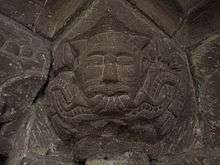 Romanesque sandstone carving, archway in church at Garway, Herefordshire, c.13th century
Romanesque sandstone carving, archway in church at Garway, Herefordshire, c.13th century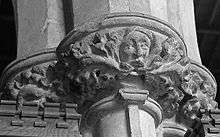 A medieval Green Man (disgorging type) on the capital of a column in an English church in Lincolnshire
A medieval Green Man (disgorging type) on the capital of a column in an English church in Lincolnshire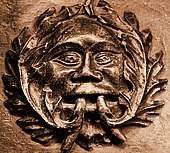
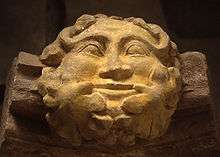 This stone carving of a Green Man from Dore Abbey, Herefordshire, England, retains some of its original colouring.
This stone carving of a Green Man from Dore Abbey, Herefordshire, England, retains some of its original colouring.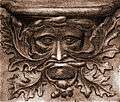 Medieval misericord; abbey-church of Vendôme, France
Medieval misericord; abbey-church of Vendôme, France- Painted wooden roof boss from Rochester Cathedral, Kent (medieval)
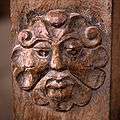 This wood carving of a "foliate head" type is on the Renaissance screen at Dore Abbey.
This wood carving of a "foliate head" type is on the Renaissance screen at Dore Abbey.
 Carved capital, south door of Maria Laach Abbey, Germany
Carved capital, south door of Maria Laach Abbey, Germany
Later variations
From the Renaissance onwards, elaborate variations on the Green Man theme, often with animal heads rather than human faces, appear in many media other than carvings (including manuscripts, metalwork, bookplates, and stained glass). They seem to have been used for purely decorative effect rather than reflecting any deeply held belief. A Swiss engraver, Numa Guyot,[10] created a bookplate depicting a Green Man in exquisite detail. It was completed circa 1887.
In Britain, the image of the Green Man enjoyed a revival in the 19th century, becoming popular with architects during the Gothic revival and the Arts and Crafts era, when it appeared as a decorative motif in and on many buildings, both religious and secular. American architects took up the motif around the same time. The Green Man travelled with the Europeans as they colonized the world. Many variations can be found in Neo-gothic Victorian architecture. He was very popular amongst Australian stonemasons and can be found on many secular and sacred buildings.[11]
Modern images
The Green Man image has made a resurgence in modern times, with artists from around the world interweaving the imagery into various modes of work.[12] Among these are English artist Paul Sivell, who created the Whitefield Green Man, a wood carving in a dead section of a living oak tree; David Eveleigh, an English garden designer who created the Penpont Green Man Millennium Maze, in Powys, Wales (the largest depiction of a Green Man image in the world); Zambian sculptor Toin Adams who created the 12m-tall Green Man in Birmingham, UK (the largest free-standing sculpture of the Green Man in the world); and sculptor M. J. Anderson, who created the marble sculpture titled Green Man as Original Coastal Aboriginal Man of All Time from Whence the Bush and All of Nature Sprouts from his Fingers.
Others include Jane Brideson, Australian artist Marjorie Bussey, American artist Monica Richards, and English fantasy artist Peter Pracownik, whose artwork has appeared in several media, including full-body tattoos.[12]
American artist Rob Juszak has taken the theme of the Green Man as Earth's spiritual protector and turned it into a vision of the Green Man cradling the planet; artist Dorothy Bowen created a kimono silk painting, titled Greenwoman, as an expression of the feminine aspect of the legend.[12]
 Banksia Man by Australian artist Graham Wilson; his reinterpretations incorporate native Australian flora.
Banksia Man by Australian artist Graham Wilson; his reinterpretations incorporate native Australian flora. The Green Man by sculptor Toin Adams at the Custard Factory, Birmingham, England[13]
The Green Man by sculptor Toin Adams at the Custard Factory, Birmingham, England[13] Green Man sculpture (1999) by Lydia Karpinska. On public view in Bloomsbury, London.
Green Man sculpture (1999) by Lydia Karpinska. On public view in Bloomsbury, London. The Whitefield Green Man, woodcarving by Paul Sivell
The Whitefield Green Man, woodcarving by Paul Sivell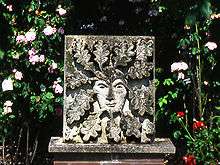 A modern garden ornament. Stonecarving by Pat Austin, David Austin Rose Garden, Albrighton (20th century)
A modern garden ornament. Stonecarving by Pat Austin, David Austin Rose Garden, Albrighton (20th century) Green Man's face on an apple tree, Nuthurst
Green Man's face on an apple tree, Nuthurst
Related characters
A character superficially similar to the Green Man, in the form of a partly foliate mask surrounded by Bacchic figures, appears at the centre of the 4th-century silver salver in the Mildenhall Treasure, found at a Roman villa site in Suffolk, England; the mask is generally agreed to represent Neptune or Oceanus and the foliation is of seaweed.[14]
In nations such as Germany, Iceland, and England, depictions of the Green Man could have been inspired by deities such as Freyr[15] or Odin, as both have many attributes of the later Green Men from throughout Europe.[16][17][18][19]
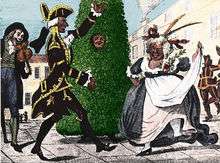
In Thomas Nashe's masque Summer's Last Will and Testament (1592, printed 1600), the character commenting upon the action remarks, after the exit of "Satyrs and wood-Nymphs", "The rest of the green men have reasonable voices ...".
Parallels have been drawn between the Green Man and various deities, including the British Celtic Lud, also known as Nodens,[20] Osiris, Odin, Dionysus, and even Jesus.[21] Father Christmas, who was often shown wreathed in ivy in early depictions, has been suggested as a similar woodland spirit.[22]
Another explanation for the disembodied head is that it is Mímir’s head from Norse Mythology. Mímir is the uncle of Óðinn and is a God of knowledge and wisdom. His Well is located in Jötunheim, the land of Ice giants. He is beheaded by the Vana Gods for controlling Hœnir, the Asa God chieftain, after the Asa-Vana war. The severed head is then sent to Óðinn who embalms the head with herbs and spices to stop it from Rotting. He then reanimates the head and keeps it with him so Mímir’s wisdom and knowledge is not lost. After the Viking Age in the UK, churches incorporated the green man motif in reference to knowledge and wisdom.
Modern Paganism
For many modern Pagans, the Green Man is used as a symbol of seasonal renewal and ecological awareness.[23]
In Wicca, the Green Man has often been used as a representation of the Horned God, a syncretic deity that incorporates aspects of, among others, the Celtic Cernunnos and the Greek Pan.
Popular culture
Literature
The Green Man is a recurring theme in literature. Sometimes the figures of Robin Hood and Peter Pan are associated with a Green Man, as is that of the Green Knight in Sir Gawain and the Green Knight. The Green Knight in this poem serves as both a monster antagonist and as mentor to Sir Gawain, belonging to a pre-Christian world which seems antagonistic to, but is in the end harmonious with, the Christian one.[24] During the post-war era literary scholars interpreted the Green Knight as being a literary representation of Lady Raglan's Green Man as described in her article "The Green Man in Church Architecture", published in the "Folklore" journal of March 1939. This association ultimately helped consolidate the belief that the Green Man was a genuine, Medieval, folkloric, figure.[25][26]
Sir James Frazer mentions the tradition in The Golden Bough. Kingsley Amis's novel The Green Man (1969) is about a modern incarnation of the Green Man, who, in the novel, is portrayed as ancient pagan monster. Stephen Fry wrote a pastiche of a poem called "The Green Man" as part of his novel The Hippopotamus. In Charles Olson's book, Archaeologist of Morning, there is a poem entitled "The Green Man". Ronald Johnson also wrote a book-length poem sequence, The Book of the Green Man. The premise has even made its way into comics, most notably with the character of Swamp Thing.
Green men, and variants on the theme, frequently occur in modern fantasy literature and science fiction. Tom Bombadil and the Ents in The Lord of the Rings could be considered possible examples. In Kenneth Grahame's 1908 children's classic The Wind in the Willows, a depiction of a natural deity, analogous with Pan and Green Man legend, appears as the climax of a mystical experience within the chapter "The Piper at the Gates of Dawn". (Later, the psychedelic rock band Pink Floyd's debut studio album took its name from that chapter.) Elsewhere, Robert Jordan's series The Wheel of Time features a character named Someshta, referred to as "the Green Man". He is the sole survivor of a race called the Nym, who were originally entrusted as the gardeners of the world, and who had the ability to manipulate the life and growth of plants around them.[27] He first appears in book one, The Eye of the World, in chapters 49 ("The Dark One Stirs") and 50 ("Meetings at the Eye"). He later reappears in book four, The Shadow Rising, in chapter 26 ("The Dedicated"), in a ter'angreal located in Rhuidean.[28] A character called "the green man" also appears in Gene Wolfe's series The Book of the New Sun. In that story, the character is a time-traveler from a possible future of Urth (i.e. Earth) where humanity has "altered [pond scum] until it can live in our blood, and by its intervention have at last made our peace in humankind's long struggle with the sun. In us, the tiny plants live and die, and our bodies feed from them and their dead and require no other nourishment. All the famines, and all the labor of growing food, are ended."
The Cornish poet Charles Causley, the 1967 winner of the Queen's Gold Medal for Poetry wrote a poem titled Green Man In The Garden.[29]
In the final years of the 20th century and earliest of the 21st, the appearance of the Green Man proliferated in children's literature.[30] Examples of such novels in which the Green Man is a central character are Bel Mooney's 1997 works The Green Man and Joining the Rainbow, Jane Gardam's 1998 The Green Man, and Geraldine McCaughrean's 1998 The Stones are Hatching.[30] Within many of these depictions, the Green Man figure absorbs and supplants a variety of other wild men and gods, in particular those which are associated with a seasonal death and rebirth.[30] The Rotherweird Trilogy by Andrew Caldecott draws heavily on the concept of the Green Man, embodied by the Gardener Hayman Salt who is transformed into the Green Man at the climax of the first book.
Music
The Green Man was a track by early English acid house outfit Shut Up and Dance who entered the UK charts in 1992. Jethro Tull performed the track Jack-in-the-Green on their 1977 album Songs from the Wood. A song "Greenman" by English band XTC featured on their album Apple Venus Volume 1 (lyrics included "See the Greenman blow his kiss from high church wall"). A song called "Green Man" is on American heavy metal band Type O Negative's album October Rust. The green man is the subject of Roy Harper's "The Green Man", the lead song on his album of the same name. The track "Diadem" on Waterson–Carthy's 2006 album Holy Heathens and the Old Green Man has phrases which suggest that the figure being adored is some kind of Green Man.
Cinema
The Green Man is featured in several films, such as The Draughtsman's Contract by Peter Greenaway (1982) and the first episode of The Canterbury Tales by Pier Paolo Pasolini (1972). The 2012 Disney film The Odd Life of Timothy Green also appears to depict a Green Man figure in its title character, a magical child who appears in the garden of a childless couple one night. He has leaves growing on his legs, takes nourishment from sunlight and returns to the earth in the fall, after fulfilling his purpose. In the 1973 horror film The Wicker Man, the local tavern of Summerisle is named 'The Green Man', and is the haunt of a group of paganistic islanders.
The Green Man has recently been depicted in The Chilling Adventures of Sabrina as an old pagan god; he is meant to bring the end to humanity "The end of all flesh" where all humans will be pollinated and killed as sacrifices to bring the Green Man back.
Outside Europe
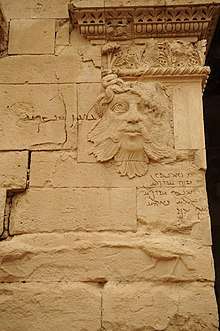
In his A Little Book of The Green Man, as well as his website, Mike Harding gives examples of similar figures in Borneo, Nepal, and India: the earliest is a foliate head from an 8th-century Jain temple in Rajasthan.[31] He also notes that heads from Lebanon and Iraq can be dated to the 2nd century and that there are early Romanesque foliate heads in 11th century Templar churches in Jerusalem. He tentatively suggests that the symbol may have originated in Asia Minor and been brought to Europe by travelling stone carvers.
On a similar theme, author on spirituality and architecture William Anderson writes:[32]
There are legends of him (Khidr) in which, like Osiris, he is dismembered and reborn; and prophecies connecting him, like the Green Man, with the end of time. His name means the Green One or Verdant One, he is the voice of inspiration to the aspirant and committed artist. He can come as a white light or the gleam on a blade of grass, but more often as an inner mood. The sign of his presence is the ability to work or experience with tireless enthusiasm beyond one's normal capacities. In this there may be a link across cultures, ... one reason for the enthusiasm of the medieval sculptors for the Green Man may be that he was the source of every inspiration.[32]
In one of his roles the ancient Egyptian God Osiris is regarded as a grain-deity and is commonly depicted with a green face representing vegetation, rebirth and resurrection. Containers of soil in the shape of Osiris planted with seed ("Osiris Beds") are found in some New Kingdom tombs. The sprouting grain implied the resurrection of the deceased.[33]
Other gods depicted green are (in Tibet) Amogha-siddhi and (in Mexico) Tlaloc.
In Sanskrit the Green Man is cognate with the gana Kirtimukha or "Face Of Glory" which is related to a lila of Shiva and Rahu. The Face of Glory is often seen in Vajrayana Buddhist Thanka art and iconography where it is often incorporated as a cloudform simulacrum; and depicted crowning the 'Wheel of Becoming' or the Bhavachakra.[34]
Khidr or al-Khidr (Arabic: الخضر al-Khiḍr "the Green One", also transcribed as Khidar, Khizr, Khyzer, Khizar) is a revered figure in Islam, whom the Qur'an describes as a righteous servant of God,[35] who possessed great wisdom or mystic knowledge.[35] He is most often said to be a contemporary of Moses, but in other variations of his story, he lived at the same time as Abraham, the mythological Persian king Afridun and Nashiya bin Amus.[36][37] The 18th sura ("The Cave") presents a narrative where Khidr accompanies Moses and tests him about his oath to not ask any questions. Tom Cheetham, an authority on Islamic mysticism, identifies Khidr of esoteric Sufism with the Green Man. In his book about the work of Henry Corbin and others concerning the 12th-century Muslim saint Ibn Arabi, he develops the idea of the Green Man/Khidr as the principle mediating between the imaginary realm and the physical world.[38]
Gallery
 Fountain found in Campo San Giacomo, Venice, Italy
Fountain found in Campo San Giacomo, Venice, Italy Sketches by Villard de Honnecourt, c.1230
Sketches by Villard de Honnecourt, c.1230 Engraving of foliate head, Hans Sebald Beham, 1543
Engraving of foliate head, Hans Sebald Beham, 1543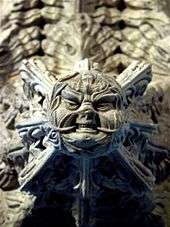 One of more than 110 Green Men carvings in Rosslyn Chapel, Scotland
One of more than 110 Green Men carvings in Rosslyn Chapel, Scotland- Foliate mask from Casa de Arizón near Cádiz, Spain (17th–18th century)

.jpg) Architectural detail, Portland, Oregon (late 19th or early 20th century?)
Architectural detail, Portland, Oregon (late 19th or early 20th century?) Illustration of the sign which hung outside a public house in Covent Garden in the 1970s
Illustration of the sign which hung outside a public house in Covent Garden in the 1970s Dramatised combat between the Green Man and Jack Frost at a community festival in Yorkshire
Dramatised combat between the Green Man and Jack Frost at a community festival in Yorkshire Costumed performer at Scarborough Faire (2007)
Costumed performer at Scarborough Faire (2007) A Green Man with the body of a faun: Green Mason by Australian artist Graham Wilson (21st century)
A Green Man with the body of a faun: Green Mason by Australian artist Graham Wilson (21st century) Carving at entrance to Schloß, Tübingen, Germany
Carving at entrance to Schloß, Tübingen, Germany Green Man by Malibu Potteries
Green Man by Malibu Potteries
See also
References
- For the "Lady of Wells" boss in the Chapter House of Wells Cathedral, see Wright, Brian (2011). Brigid: Goddess, Druidess and Saint. The History Press. p. 183. ISBN 978-0752472027.
- Cheade, Shirlyn. "Green Man Mythology". TarValon.net Library. Retrieved 1 September 2011.
- Jenks, Kathleen. "Common Themes East & West: The Green Man". Myth*ing Links. Archived from the original on 2012-08-05. Retrieved 1 September 2011.
- Raglan, Lady (March 1939). "The Green Man in Church Architecture". Folklore. 50 (90990): 45–57. doi:10.1080/0015587x.1939.9718148. JSTOR 1257090.
- ": Theories and Interpretations". The Enigma of the Green Man. Retrieved 24 August 2016.
- Centerwall, Brandon S. (1997). "The Name of the Green Man". Folklore. 108: 25–33. doi:10.1080/0015587x.1997.9715933.
- Harding, Mike (1998). A Little Book Of The Green Man. Aurum Press. p. 38. ISBN 1-85410-561-2. Archived from the original on 2011-07-10.
- Pesznecker, Susan (2007). Gargoyles: From the Archives of the Grey School of Wizardry. Franklin Lakes NJ: Career Press. pp. 127–128. ISBN 1-56414-911-0.
- Anderson, William (1990). Green Man. Harpercollins. p. 46. ISBN 0-06-250077-5.
- Numa Archived 2016-01-07 at the Wayback Machine, Guyot Brothers
- "Green Man on Broadway". June 7, 2006 – via Flickr.
- Phyllis Araneo. "Green Man Resurrected: An Examination of the Underlying Meanings and Messages of the Re-Emergence of the Ancient Image of the Green Man in Contemporary, Western, Visual Culture". Master's thesis: University of the Sunshine Coast, 2006. Queensland, Australia.
- The Birmingham Post, June 2002
- Illustrated (British Museum highlights:Great dish from the Mildenhall treasure Archived 2015-10-18 at the Wayback Machine)
- Harding, Paul, Joseph Bindloss, Joseph, & Cornwallis, Graeme. Iceland, Lonely Planet (2004) ISBN 1-74104-076-0, ISBN 978-1-74104-076-0
- "Celtic London: evidence of worship of the Horned God". Fantompowa.net. Retrieved 2013-03-19.
- Archived July 10, 2011, at the Wayback Machine
- "Flame Online 2001: Readers Comments". Fantompowa.net. Retrieved 2013-03-19.
- "Heathen Fun". Home.earthlink.net. 2003-07-20. Archived from the original on 2012-08-14. Retrieved 2013-03-19.
- Baring, Anne; Cashford, Jules (1991). The Myth of the Goddess. London: Penguin. pp. 411–2. ISBN 0-14-019292-1.
- Harding, Mike, A Little Book of the Green Man, photography by Mike Harding, Aurum Press, London, 1989 p. 12
- Siefker, Phyllis (February 1997). Santa Claus, Last of the Wild Men: The Origins and Evolution of Saint Nicholas, Spanning 50,000 Years. McFarland & Co. ISBN 0-7864-0246-6.
- Bramwell 2009, p. 53.
- Braudy, Leo (Oct 25, 2016). Haunted: On Ghosts, Witches, Vampires, Zombies, and Other Monsters of the Natural and Supernatural Worlds. Yale University Press. p. 277. ISBN 0300224729. Retrieved 28 September 2017.
- Larrington, Carolyne (2015). The Land of the Green Man: A Journey Through the Supernatural Landscapes of the British Isles. I.B.Tauris. p. 227. ISBN 1780769911.
- Mastin, Luke. "THEORIES AND INTERPRETATIONS". www.greenmanenigma.com. Retrieved 28 September 2017.
- Jordan, Robert (1990). The Eye of the World. Tor Books (US) and Orbit (UK). ISBN 0-312-85009-3. (US hardback edition) ISBN 1-85723-353-0(UK hardback edition).
- Jordan, Robert (1992). The Shadow Rising. Tor Books (US) and Orbit (UK). ISBN 0-312-85431-5. (US hardback edition) ISBN 1-85723-079-5(UK hardback edition).
- "Charles Causley Biography". www.poetrysoup.com. Retrieved 2018-08-03.
- Bramwell 2009, p. 59.
- "The Official Mike Harding Web Site". Mikeharding.co.uk. Retrieved 2013-03-19.
- Anderson, William (1990). Green Man: The archetype of our oneness with the Earth. San Francisco, CA: Harper Collins. ISBN 0-06-250075-9.
- Hart, George, ed. (2005). Routledge Dictionary of Egyptian Gods and Goddesses. Routledge. p. 119. ISBN 0-415-34495-6.
- Beer, Robert (1999). The Encyclopedia of Tibetan Symbols and Motifs. Shambhala. ISBN 1-57062-416-X. ISBN 978-1-57062-416-2
- Qur'an, 18:65
- "al-Khadir (al-Khidr)". Encyclopedia of Islam (Second ed.). Retrieved 21 April 2012.
- Qur'an, 18:64–65
- Cheetham, Tom (2004). Green Man, Earth Angel. Albany, NY: State University of New York. ISBN 0-7914-6270-6.
Sources cited
- Basford, Kathleen (1998) [1978]. The Green Man. Cambridge: D. S. Brewer. ISBN 978-0859914970.CS1 maint: ref=harv (link)
- Bramwell, Peter (2009). Pagan Themes in Modern Children's Fiction: Green Man, Shamanism, Earth Mysteries. New York: Palgrave Macmillan. ISBN 978-0-230-21839-0.CS1 maint: ref=harv (link)
Further reading
- Amis, Kingsley. The Green Man, Vintage, London (2004) ISBN 0-09-946107-2 (Novel)
- Anderson, William. Green Man: The Archetype of our Oneness with the Earth, Harper Collins (1990) ISBN 0-00-599252-4
- Basford, Kathleen. The Green Man, D.S. Brewer (2004) ISBN 0-85991-497-6 (The first monograph on the subject, now reprinted in paperback)
- Beer, Robert. The Encyclopedia of Tibetan Symbols and Motifs Shambhala. (1999) ISBN 1-57062-416-X, ISBN 978-1-57062-416-2
- Cheetham, Tom. Green Man, Earth Angel: The Prophetic Tradition and the Battle for the Soul of the World , SUNY Press 2004 ISBN 0-7914-6270-6
- Doel, Fran and Doel, Geoff. The Green Man in Britain, Tempus Publishing Ltd (May 2001) ISBN 0-7524-1916-1
- Harding, Mike. A Little Book of the Green Man, Aurium Press, London (1998) ISBN 1-85410-563-9
- Hicks, Clive. The Green Man: A Field Guide, Compass Books (August 2000) ISBN 0-9517038-2-X
- MacDermott, Mercia. Explore Green Men, Explore Books, Heart of Albion Press (September 2003) ISBN 1-872883-66-4
- Matthews, John. The Quest for the Green Man, Godsfield Press Ltd (May 2004) ISBN 1-84181-232-3
- Neasham, Mary. The Spirit of the Green Man, Green Magic (December 2003) ISBN 0-9542963-7-0
- Varner, Gary R. The Mythic Forest, the Green Man and the Spirit of Nature, Algora Publishing (March 4, 2006) ISBN 0-87586-434-1
External links
| Wikimedia Commons has media related to Green Man. |
- The surprising roots of the green man short BBC documentary (video)
- The Beneficent Order of the Greenman—Fraternal Order dedicated to the image Hosting an extensive collection of links on the subject
- Clun Green Man Festival in South Shropshire
- The Breinton Morris — Who is the Green Man?
- Green Man on bosses at Canterbury Cathedral
- The Green Man in Birmingham
- The Green Man: Variations on a Theme
- Sean Breadin's Green Man Page Alternative perspectives, striking images, together with several short films from a number of UK locations.
- The name of the Green Man Research paper by Brandon S Centerwall from Folklore magazine
- mythinglinks.org
- The Green Man of Cercles Julianna Lees on Green Man sculptures in Romanesque Churches in France
- Carved Green Man various examples of native Australian style Green Men and play written about the Green Man
- Green Men in Germany a catalogue of photos of Green men in Germany
- Green Men in The Netherlands many neo-gothic and a few medieval examples
- Hastings Jack in the Green Festival held from late April – early May
- Greenman Encyclopedia Wiki A site with a comprehensive listings of locations of Green Men in the UK
